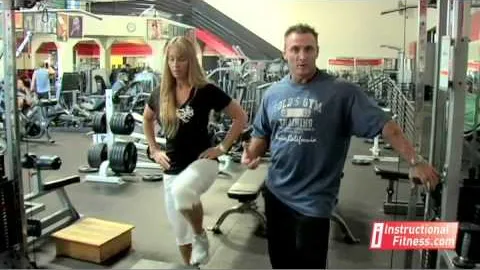
Looking to amp up your lower body workout routine? Look no further than the bench step-up exercise. This versatile movement targets multiple muscle groups, improves strength, and enhances stability. Whether you're a seasoned athlete or a beginner, adding bench step-ups to your fitness regime can yield impressive results. Read on to discover the incredible benefits of this exercise and learn how to perform it correctly for maximum effectiveness.
Improved Lower Body Strength: The bench step-up primarily targets your quadriceps, hamstrings, glutes, and calf muscles. By focusing on these muscle groups, you can develop explosive lower body strength, enabling you to perform other activities more effectively.
Enhanced Stability and Balance: Bench step-ups help improve your proprioception, which is your body's ability to sense its position, motion, and balance. Strengthening the muscles responsible for stability and balance can reduce the risk of falls and injuries during everyday activities.
Increased Caloric Burn: As a compound exercise, bench step-ups engage multiple muscle groups simultaneously, requiring more energy and causing a higher caloric burn. By incorporating this exercise into your routine, you can maximize your calorie expenditure and support weight management goals.
Versatility and Accessibility: Bench step-ups can be performed virtually anywhere with a sturdy bench or platform. Whether you're at the gym, in the park, or even at home, this exercise is accessible and can be modified to suit your fitness level.
Starting Position: Stand in front of a steady bench or platform, ensuring it is secure and balanced. Keep your feet hip-width apart and your hands comfortably positioned at your sides.
Step-Up: Step onto the bench with your right foot, pushing through your heel and ensuring that your foot is fully placed on the surface. As you begin to straighten your right leg, engage your glutes and quads to lift your body onto the bench.
Top Position: At the top of the movement, ensure that both feet are securely positioned on the bench. Stand tall, maintaining a neutral spine and engaged core.
Step-Down: Carefully step down with your left foot, followed by your right foot, returning to the starting position.
Alternating Legs: Repeat the exercise by starting with your left foot on the bench and continue to alternate legs for a balanced workout.
Beginners: If you're new to bench step-ups, begin with a lower platform or step to ensure proper form and reduce the risk of injury. Gradually increase the height of the platform as you gain strength and confidence.
Engage Your Core: Throughout the exercise, remember to engage your core muscles by drawing your navel towards your spine. This will help maintain stability and protect your lower back.
Controlled Movements: Perform the exercise slowly and with control, focusing on the muscle groups being targeted. Avoid using momentum or swinging your body, as this can diminish the effectiveness of the exercise and increase the risk of injury.
Progressive Overload: To continually challenge your muscles and see progress, consider adding extra resistance using dumbbells, a weighted vest, or resistance bands. Gradually increase the weight or resistance over time to further enhance your strength and endurance.
Proper Breathing: Inhale as you prepare for the step-up, exhale as you push through your heel to lift your body, and continue to breathe rhythmically throughout the exercise.
Consult a Professional: If you have any pre-existing medical conditions or concerns, it's advisable to consult a qualified fitness professional or healthcare provider before incorporating bench step-ups into your routine.
Modifications for Joint Issues: If you have knee or ankle issues, consider performing a partial step-up by only lifting your foot onto the bench without fully extending your leg. Additionally, you can opt for a lower step or platform to reduce joint stress.
Balance Assistance: If you struggle with balance, use a wall or sturdy object for support. You can lightly touch the object with one hand while performing the step-up to maintain stability.
As a low-impact exercise with high impact results, bench step-ups are a fantastic addition to your workout routine. By consistently incorporating this exercise into your training program, you can improve lower body strength, stability, balance, and overall athleticism. Remember to start with proper form, progress at your own pace, and consult a professional if needed. Lace-up your training shoes, grab a bench or step, and step up your fitness game with bench step-ups today!
If you're looking for a gym, fitness club or yoga studio, you've come to the right place.
You can find information about gyms in your area. Browse catalog of gyms and find gyms with classes which are you looking for.
On gym page you can find simple information like address, phone or website. You can find list of available classes. You can check availability of personal training or small group classes. On place page you can also see information about open hours.
You can find gyms near you with amenities, courts, studios and equipments.
Use our map to find gym at your city or district.
In Gym Navigator you can find list of exercises with movies for many body parts.
You can browse exercises catalog and find exercises the best of you.
You can also find exercises grouped into workout plans, which you can use to improve you body. Each routine show you exercises one by one and give you possibility to count you progress and count down rest time.